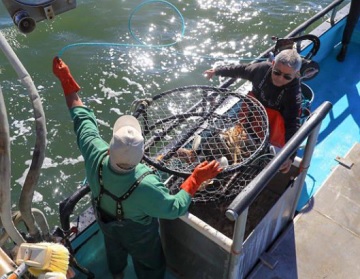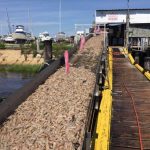Tag Archives: domoic acid
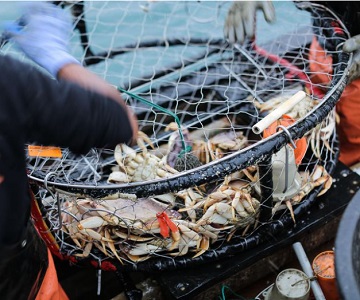
Here’s why the West Coast Dungeness crab season has been delayed
Oregon’s most valuable commercial fishery, Dungeness crab, will have its season delayed from its traditional Dec. 1 start date because of low meat yields. Testing shows the crabs in some ocean areas off the West Coast don’t have enough meat in them to satisfy the commercial market. In some areas, testing also showed elevated levels of the naturally occurring toxin domoic acid, which can make the crabs unsafe to eat. ODFW conducts tests out of six major crabbing ports in partnership with the Oregon Dungeness Crab Commission and the Oregon Department of Agriculture. Oregon, California and Washington coordinate on commercial season opening dates, and the other states will also be delaying their crab season until at least Dec. 16. >click to read< 12:10
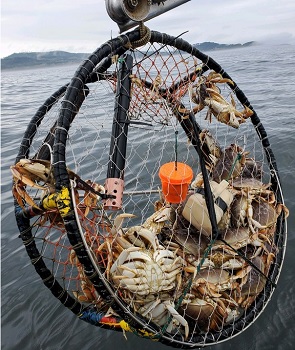
Pacific Coast crabs are suffocating
The crab pots are piled high at the fishing docks in Newport, Oregon. Stacks of tire-sized cages fill the parking lot, festooned with colorful buoys and grimy ropes. By this time in July, most commercial fishers have called it a year for Dungeness crab. But not fisherman Dave Bailey,,, Recent years have also brought outbreaks of domoic acid, which renders crab unsafe to eat, and increasing incidents of humpback whales getting tangled in crab gear. However, there’s another emerging problem that threatens not only Bailey’s livelihood but the very ecosystem that sustains it. I’ve come today to see 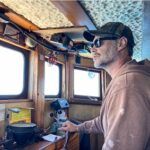 a tool that could help crabbers manage. On the counter in the kitchenette, amid bowls of instant noodles and tinned oysters, Bailey shows me a sturdy black tube, about 60 centimeters long, that fits neatly inside a crab pot. Photos, video, >click to read< 13:25
a tool that could help crabbers manage. On the counter in the kitchenette, amid bowls of instant noodles and tinned oysters, Bailey shows me a sturdy black tube, about 60 centimeters long, that fits neatly inside a crab pot. Photos, video, >click to read< 13:25
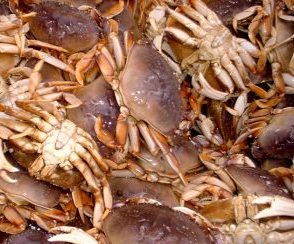
Oregon: Dungeness crab season starts Dec.1!
It’s the first time in seven years that the season has not been delayed by low meat yields, high levels of domoic acid, or both.,, But the scheduled opening has been delayed in recent years. In some years, parts of the coast have remained closed into late January. This year, commercial crab vessels can set gear Nov. 28, and begin pulling pots on Dec. 1. >click to read< 07:37
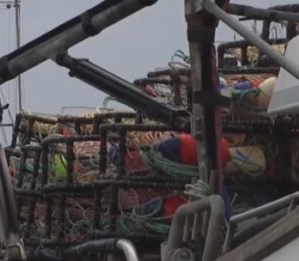
Oregon commercial crab fishery to open north of Cape Falcon Feb. 16
This area has remained closed to commercial crabbing to coordinate an orderly start with the Washington coastal Dungeness crab fishery. Results from recent domoic acid testing of crab viscera (guts) conducted by the state of Washington indicate that levels of the marine biotoxin domoic acid are still elevated in the viscera of crab. Until further notice, all crab harvested from Point Chehalis, Wash. to the Washington/Oregon border will be required to have the viscera (guts) removed ,,, Prior to the opener, crab vessels in this area will be allowed to set gear from Feb. 13 onwards, >click to read< 07:43
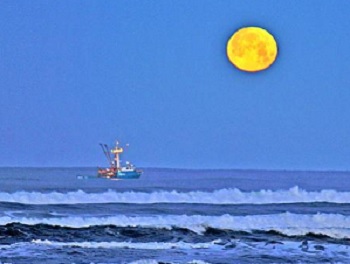
Crabbing families deserve TLC in this tough season
In normal times, this year’s disastrous Dungeness crab season would be big news beyond the coast. Even in this abnormal year, it’s time for elected officials and agencies to pay closer attention to how local families are being hurt by lack of crabbing. Typical measures of economic pain fail to capture the extent of damage.,, The most immediate problem for both commercial crabbing and recreational clamming is the marine toxin domoic acid,,, There are a lot of needy folks this year. That creates a risk that crab-dependent families may be overlooked. This fishery is a disaster and should be treated as an emergency. >click to read< 20:22
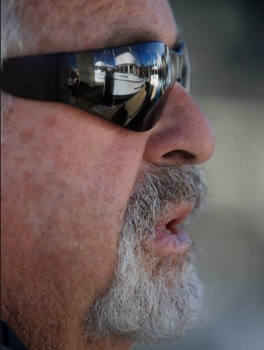
California: Don’t expect Dungeness Crab for Christmas this year
“Unless a miracle happens, which is highly unlikely, we won’t see crab for Christmas,” said Tony Anello, a veteran fisher who runs his boat, the Annabelle, out of Bodega Bay and offers up his tender product at Spud Point Crab Co. After several years of varied setbacks and more than a month of delays to the 2020 Dungeness season, local crabbers now face a new hurdle as they haggle over price with large wholesalers. “We should be traveling right now,” Dick Ogg,,, wholesalers are asking skippers to cut their prices by 30% to 35%, leaving both sides approximately $1 a pound apart from an agreement that would start the crab season. >click to read< 08:05
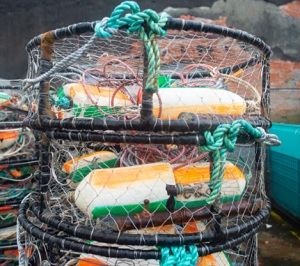
Researchers find new toxin hot spot
As high levels of domoic acid once again delay the opening of the commercial Dungeness crab fishery in Washington state and along Oregon’s North Coast, researchers say they have zeroed in on a like cause of marine toxin issues farther south. They recently identified a new highly toxic hot spot between California’s Cape Mendocino, several hundred miles north of San Francisco, and Oregon’s Cape Blanco, north of Port Orford, according to a study published this month. >click to read< 16:04

California Dungeness Crab season opens Dec. 23
The official opening date of Nov. 15 had been delayed for weeks in the central California zone, from the Sonoma/Mendocino county line south, because of the possibility of migrating whales getting tangled in fishing lines. And it had been delayed in the northern zone, which consists of Humboldt, Mendocino and Del Norte counties, because the sample catch failed to reach the poundage required for testing.,, Since 2015, there have been delays in all but one commercial Dungeness season. A toxin, domoic acid, that could sicken anyone who eats the tainted crab destroyed Northern California’s 2015-2016 commercial season and created delays in other years. >click to read< 09:52

WDFW: Toxin domoic acid delays commercial Dungeness crab season until at least Jan. 1
The commercial Dungeness crab season opener faces a delay until at least Jan. 1 due to an excess of the marine toxin domoic acid in the guts of sampled crab, the Tri-State management group announced Tuesday evening, Dec. 8. The season had been previously set to start Dec. 16, depending on whether crab reached required minimum meat standards by then. “This decision was based on domoic acid tests of Dungeness crab collected by WDFW and analyzed by the Washington Department of Health,,, >click to read< 08:31
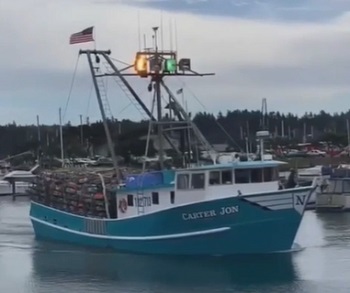
Delay in Dungeness crab season the latest in long string of delayed seasons
The Oregon Dungeness crab season has been delayed two weeks with a start date now set for December 16. It’s the latest in a long string of delayed seasons. The season start date is supposed to be December 1, but for six consecutive seasons it’s been delayed. “It’s a moving goalpost all the time with the Dungeness crab fishery and yeah, I guess were used to waiting here because the state makes the decision when we get to open the season,” says Nick Edwards, owner of F/V Carter Jon. >video, lick to read< 10:36
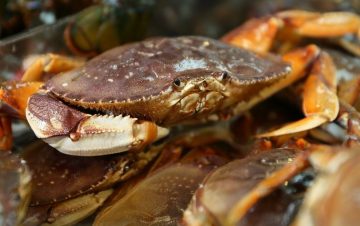
California coasts recovering, but more marine heatwaves like ‘The Blob’ expected
The effects of the marine heatwave off the California coast from 2014 to 2016, better known as The Blob, that led to a decrease in Chinook salmon and virtually shut down the Dungeness crab industry are finally starting to wear off.,,, “It wasn’t about (a lack of) abundance,” said Noah Oppenheim, executive director of the Pacific Coast Federation of Fishermen’s Associations. “It was about destabilized ecosystems.” >click to read< 10:50
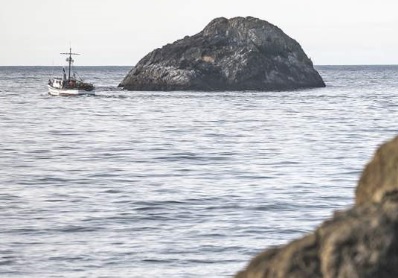
Crab fleet gearing up for season
Crab fishermen began setting their pots today in preparation for opening day of the 2019 commercial Dungeness season. Following a delay of about six weeks due to concerns about quality and domoic acid, the commercial Dungeness season between Patrick’s Point and the Oregon border opens at 12:01 a.m. Friday, according to a press release from the California Department of Fish and Wildlife. The commercial fleet could begin setting their gear at 8:01 a.m. today, according to the release. >click to read<11:41

Crab Fishermen Warn: With the Season Closed Elsewhere, Loads of Out-of-Town Crabbers Will be Coming to Humboldt and There’s Hardly Any Places to Tie Up
From the Humboldt Fishermen’s Marketing Association: North Coast crab fishermen from Fort Bragg to Crescent City are facing double jeopardy — one from a warming ocean and one man made by a local agency. As of January 8, 2019, the date of the most recent test results for Domoic Acid levels in Dungeness Crabs, both the Patrick’s Point test (north of Trinidad) and the Crescent City test failed due to one crab each over the 30 ppm,,, >click to read<12:44
Harbor may see influx of transient crabbing vessels with season set to begin – >click to read<15:01

Fishermen unite to sue big oil
Almost a month has gone by since fishermen in California and Oregon filed suit against big oil in California’s Superior Court, demanding compensation for damages done to the fishing industry. The lawsuit is colloquially being called the crabbers’ suit because many of the members making up the plaintiff, The Pacific Coast Federation of Fishermen’s Associations, rely on crabbing for their livelihoods. The federation is suing the fossil fuel industry, including major companies like Chevron, ExxonMobil, BP, and Shell Oil, under the claim that it has known about the dangers of fossil fuels and climate change for decades but has deliberately hidden information from the public as well as spread misinformation campaigns. >click to read>12:35

McGuire tackles crabbing, whale entanglement issues at committee hearing
“Domoic acid levels in the Pacific this year have been trending upwards, especially in Northern California,” McGuire said at the start of the hearing, held at Aquarium of the Bay in San Francisco. “Humboldt, Del Norte and southern Oregon have appeared as hot spots along the West Coast.” And while the 2015 crabbing season and spike in entanglements was one of the more talked-about issues during the hearing, McGuire added, “We do not expect another statewide closure like we saw in 2015.” This year alone, there have been 27 confirmed whale entanglements. That’s down from the 71 reported in 2016, but it is still more than double the state average.>click to read<10:31
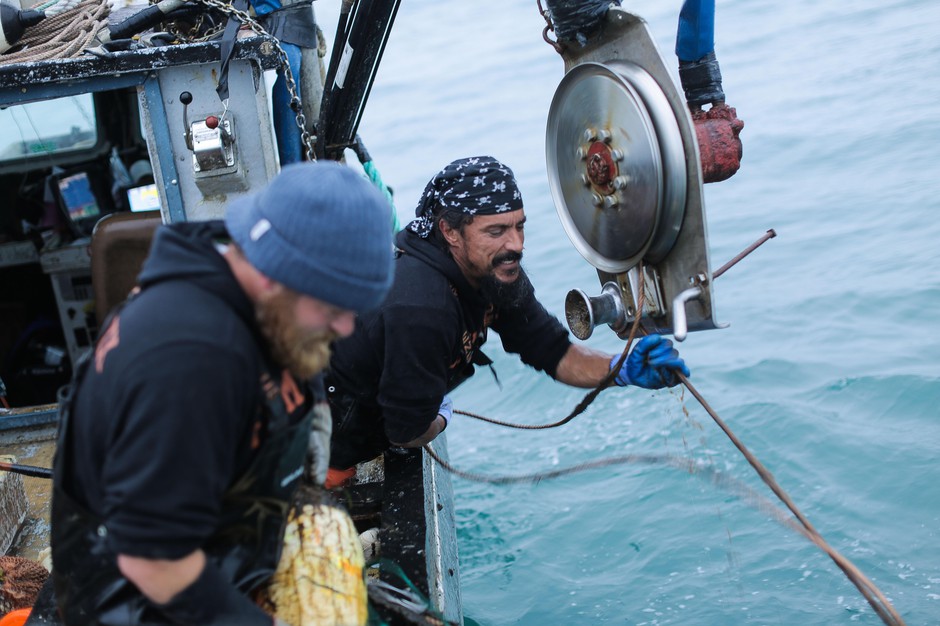
‘There Aren’t A Lot Of Other Options’: Port Orford’s Season Of Crab And Crisis
Oregon’s 2018 toxic algae troubles didn’t begin with the summer bloom tainting Salem’s water supply. The opening salvo actually came from the wintry Pacific, where high levels of domoic acid — a neurotoxin byproduct of marine algae blooms — disrupted seafood production along Oregon’s South Coast. For Port Orford in particular, where the fishing industry sustains about one-third of the local economy, this meant a season of loss instead of bounty. By the numbers, Port Orford really can’t afford more economic distress. >click to read<10:58

Oregon Senate Passes Seafood Bill – would require more frequent testing of acid levels
After recreational crabbing along the southern Oregon coast was closed last week due to domoic acid levels, the Oregon Senate has now passed a bill aimed at better pinpointing where these toxins are flourishing. The bill will now go on to the state House of Representatives for consideration. Under current conditions, whole crabbing regions have to be shut down in order to ensure safety. The bill would require more frequent testing of acid levels, so that affected areas could be more easily identified—and, ideally, these areas of closure would be much smaller in size.,,, Commercial crabbing season has been delayed due to a combination of factors. >click to read< 18:48

A bad season for crab – Domoic acid levels high again, meat content poor, crustaceans start to molt
The Oregon Department of Agriculture is ordering crab fishermen to eviscerate or destroy any crab caught since Feb. 13 after tests Wednesday showed domoic acid is again at unacceptable levels. There is also a recall on all live or whole-cooked crab caught since Feb. 13, said Troy Buell, fishery manager with Oregon Department of Fish and Wildlife. Recreational crabbing in Curry County has also been closed. The news comes nine days after the long-delayed crabbing season opened in the last section on the Oregon Coast. >click to read< 09:01
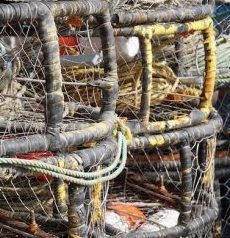
Crab Fishing in California: Risky Business
Dungeness crab, buttery and served steaming hot, is a Christmas tradition on many central California tables. But two years ago families had to forgo their holiday treat, and they were not the only ones to suffer. California fishermen were crippled by an unprecedented algal bloom that contaminated crabs with a neurotoxin called domoic acid, which is deadly to humans. That shut business down through the most lucrative part of the season, from Thanksgiving to Christmas. click here to read the story 11:41

Death by Killer Algae
They didn’t think much of the first dead whale. Dwarfed by the rugged cliffs of Patagonia’s high green fjords, the team of biologists had sailed into a gulf off the Pacific Ocean searching for the ocean’s smaller animals, the marine invertebrates they were there to inventory. That night, while hunting for an anchorage in a narrow bay, the team spotted a large, dead whale floating on the water’s surface. But for the biologists, death—even of such an enormous animal—didn’t seem so unusual. Not so unusual, that is, until they found the second whale, lying on the beach. And a third. And a fourth. In all, they found seven in that bay alone. Over the next day, they counted a total of 25 dead whales in the fjord. click here to read the story 15:42
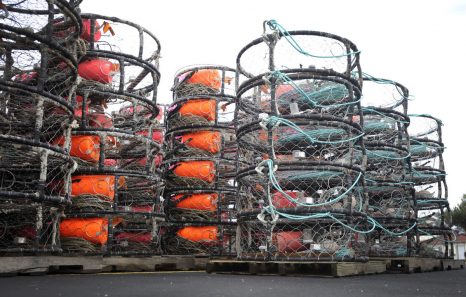
Oregon: Bay crabbing closures leave businesses empty
The Oct. 15 closure of both recreational and commercial crabbing came as quite a surprise to many local businesses who rely on bay crabbing in the months leading up to the Dec. 1 ocean crabbing season.,,, The Oregon Department of Fish and Wildlife along with the Oregon Department of Agriculture closed crabbing after noticing increased levels of domoic acid in local Dungeness crabs coming out of the bay. However, locals who financially rely on crabbing feel this isn’t as dangerous as state agencies are making it out to be. click here to read the story 09:08

Fingers crossed there won’t be anything to be crabby about this season
With their pots stacked high and boat decks washed, commercial crab fishermen along the Central Coast are prepped for a season that is expected to start next Wednesday, on-time for the first time since 2014. And the getting could be good. “Ocean conditions over the past couple years, as the crabs that we’ll catch this year have matured, have been pretty good,” says Noah Oppenheim, executive director of the Pacific Coast Federation of Fishermen’s Associations in San Francisco. “It was good enough that we think the resources will be very healthy.” “Brutal,” “devastating,” “a disaster,” are all ways fishermen and heads of the industry have described the crab seasons of 2015 and 2016,,, click here to read the story 09:25
Dungeness crab season could be delayed again by the toxin domoic acid
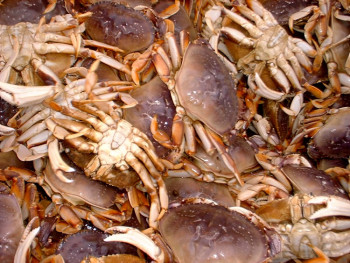 Dungeness crab season is approaching in the Bay Area, along with all the rituals that come with it — the crab feeds and holiday dinners piled with crab legs, sourdough bread and crocks of melted butter. Unfortunately, there’s another, more recent local tradition that is also back: uncertainty about whether algal blooms will delay the season. Domoic acid is the naturally occurring toxin caused by algal blooms that delayed the past two Dungeness crab seasons. According to test results from the California Department of Public Health, elevated levels of the toxin have shown up in samples of Dungeness crab collected in recent weeks at several North Coast ports. However, the agency said it’s too soon to say whether domoic acid will delay the commercial Dungeness fishery, due to open Nov. 15. click here to read the story 11:05
Dungeness crab season is approaching in the Bay Area, along with all the rituals that come with it — the crab feeds and holiday dinners piled with crab legs, sourdough bread and crocks of melted butter. Unfortunately, there’s another, more recent local tradition that is also back: uncertainty about whether algal blooms will delay the season. Domoic acid is the naturally occurring toxin caused by algal blooms that delayed the past two Dungeness crab seasons. According to test results from the California Department of Public Health, elevated levels of the toxin have shown up in samples of Dungeness crab collected in recent weeks at several North Coast ports. However, the agency said it’s too soon to say whether domoic acid will delay the commercial Dungeness fishery, due to open Nov. 15. click here to read the story 11:05
Commercial Spiny Lobster Fishery Closed at Anacapa Island and the East End of Santa Cruz Island Due to Public Health Hazard
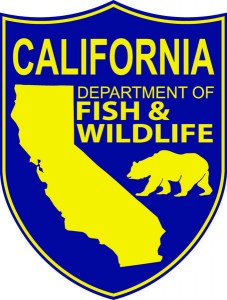 California Department of Fish and Wildlife (CDFW) Director Charlton H. Bonham has enacted a commercial spiny lobster fishery closure effective immediately. State health agencies determined that spiny lobster near Anacapa Island, Ventura County and the east end of Santa Cruz Island, Santa Barbara County had unhealthy levels of domoic acid and recommended closure of the commercial fishery. The recreational fishery for spiny lobster remains open statewide with a warning from the California Department of Public Health (CDPH) to recreational anglers to avoid consuming the viscera (tomalley) of spiny lobster. click here to read the story 21:30
California Department of Fish and Wildlife (CDFW) Director Charlton H. Bonham has enacted a commercial spiny lobster fishery closure effective immediately. State health agencies determined that spiny lobster near Anacapa Island, Ventura County and the east end of Santa Cruz Island, Santa Barbara County had unhealthy levels of domoic acid and recommended closure of the commercial fishery. The recreational fishery for spiny lobster remains open statewide with a warning from the California Department of Public Health (CDPH) to recreational anglers to avoid consuming the viscera (tomalley) of spiny lobster. click here to read the story 21:30
Mystery of world’s worst toxic algal blooms solved: Cold water upswells from the deeper ocean
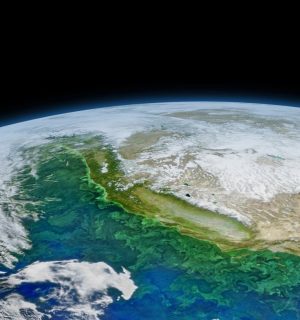 The most deadly algal blooms have extremely high levels of the neurotoxin domoic acid, which causes paralytic food poisoning and in rare cases amnesia or death if people eat contaminated shellfish. Scientists now think they have discovered why such blooms happen. It was previously thought that a pocket of warm water, known as a ‘warm blob’, was to blame. A study in Geophysical Research Letters has now identified that in fact upwelling of cold water from the deep oceans was responsible. click here to read the story 09:31
The most deadly algal blooms have extremely high levels of the neurotoxin domoic acid, which causes paralytic food poisoning and in rare cases amnesia or death if people eat contaminated shellfish. Scientists now think they have discovered why such blooms happen. It was previously thought that a pocket of warm water, known as a ‘warm blob’, was to blame. A study in Geophysical Research Letters has now identified that in fact upwelling of cold water from the deep oceans was responsible. click here to read the story 09:31
Domoic Acid raises its ugly head again…crab fishing closure
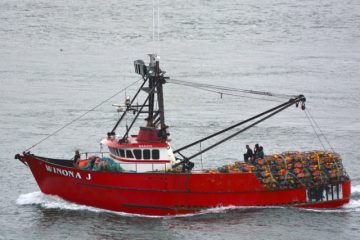 Commercial crabbing closed from Coos Bay north jetty to Heceta Head due to domoic acid The Oregon Department of Agriculture and the Oregon Department of Fish and Wildlife announce the closure of the commercial crab fishery from the north jetty of Coos Bay to Heceta Head, just south of Yachats, due to elevated levels of domoic acid in crab viscera. The area is also closed to recreational harvest. Crab meat remains safe for consumption. Domoic acid levels are elevated only in crab viscera, or the guts, of crab sampled and tested from this area of the Oregon coast. The closure is limited to that portion of the central coast. Areas south of Coos Bay and north of Heceta Head remain open to commercial crabbing. Read the story here 07:38
Commercial crabbing closed from Coos Bay north jetty to Heceta Head due to domoic acid The Oregon Department of Agriculture and the Oregon Department of Fish and Wildlife announce the closure of the commercial crab fishery from the north jetty of Coos Bay to Heceta Head, just south of Yachats, due to elevated levels of domoic acid in crab viscera. The area is also closed to recreational harvest. Crab meat remains safe for consumption. Domoic acid levels are elevated only in crab viscera, or the guts, of crab sampled and tested from this area of the Oregon coast. The closure is limited to that portion of the central coast. Areas south of Coos Bay and north of Heceta Head remain open to commercial crabbing. Read the story here 07:38
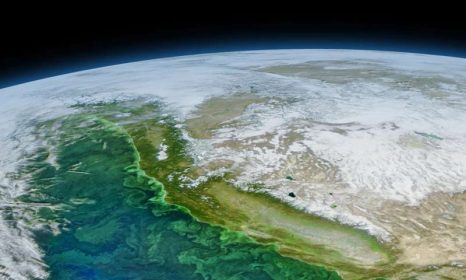
El Nino, Pacific Decadal Oscillation implicated in domoic acid shellfish toxicity
Using a combination of time-series data spanning two decades, the scientists not only showed a clear link between domoic acid and these larger climatic phenomena, but also developed a new model to predict with some accuracy the timing of domoic acid risks in the Pacific Northwest. The model is based on interpreting the status of the “Oceanic Niño Index” and the Pacific Decadal Oscillation – both of which are measures of climate, ocean water movement, currents and temperature. It’s designed to help coastal resource managers more effectively monitor this issue and protect public health. The findings were made by researchers from Oregon State University, the University of Oregon, the National Oceanic and Atmospheric Association (NOAA), and the Oregon Department of Fish and Wildlife. The work was primarily supported by NOAA. Read the article here 08:01
Sonoma Coast Dungeness crab season delayed
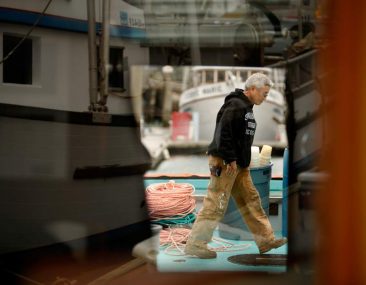 Thousands of crab traps, stacked six feet or higher, line the sides of Westshore Road surrounding the Spud Point Marina, a clear indication this year’s commercial Dungeness crab season along the North Coast is off to another rocky start. “Look at what’s happening at Spud Point — there’s probably 10,000 pots sitting out there. Those are guys who aren’t going out,” said Charlie Beck, a Bodega Bay fisherman who has been crabbing in the waters off the Sonoma Coast nearly 40 years. “Our small fishing fleet is getting destroyed. Last year was the worst season that we’ve ever seen, and this year it’s looking pretty bleak, especially for the smaller boats.” State health officials last week recommended an indefinite delay for Dungeness along a 180-mile stretch of coastal waters along Northern California, from Point Reyes in Marin County to Humboldt Bay in Mendocino County, dealing another blow to the North Coast’s lucrative wintertime crabbing season following last year’s 4½-month delay. Read the story here with 12 images 10:01
Thousands of crab traps, stacked six feet or higher, line the sides of Westshore Road surrounding the Spud Point Marina, a clear indication this year’s commercial Dungeness crab season along the North Coast is off to another rocky start. “Look at what’s happening at Spud Point — there’s probably 10,000 pots sitting out there. Those are guys who aren’t going out,” said Charlie Beck, a Bodega Bay fisherman who has been crabbing in the waters off the Sonoma Coast nearly 40 years. “Our small fishing fleet is getting destroyed. Last year was the worst season that we’ve ever seen, and this year it’s looking pretty bleak, especially for the smaller boats.” State health officials last week recommended an indefinite delay for Dungeness along a 180-mile stretch of coastal waters along Northern California, from Point Reyes in Marin County to Humboldt Bay in Mendocino County, dealing another blow to the North Coast’s lucrative wintertime crabbing season following last year’s 4½-month delay. Read the story here with 12 images 10:01
Crabbing halted off Oregon coast
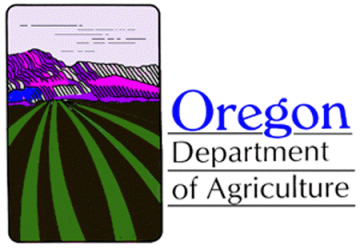 State agriculture officials in Oregon have shut down commercial and recreational crabbing along the entire coast because of high levels of domoic acid found in the crabs’ flesh. The says the ban includes the harvest of Dungeness and red rock crab in bays and estuaries, off docks, piers, jetties and in the ocean. Consumption of domoic acid can result in dizziness, headaches, vomiting and diarrhea. More severe cases can result in memory loss and death. Closure of the crab season last year along the Pacific coast due to domoic acid contamination caused crabbers to lose millions. Despite the delay, crab and shellfish products sold in retail markets and restaurants remain safe for consumers. Link 08:40
State agriculture officials in Oregon have shut down commercial and recreational crabbing along the entire coast because of high levels of domoic acid found in the crabs’ flesh. The says the ban includes the harvest of Dungeness and red rock crab in bays and estuaries, off docks, piers, jetties and in the ocean. Consumption of domoic acid can result in dizziness, headaches, vomiting and diarrhea. More severe cases can result in memory loss and death. Closure of the crab season last year along the Pacific coast due to domoic acid contamination caused crabbers to lose millions. Despite the delay, crab and shellfish products sold in retail markets and restaurants remain safe for consumers. Link 08:40






